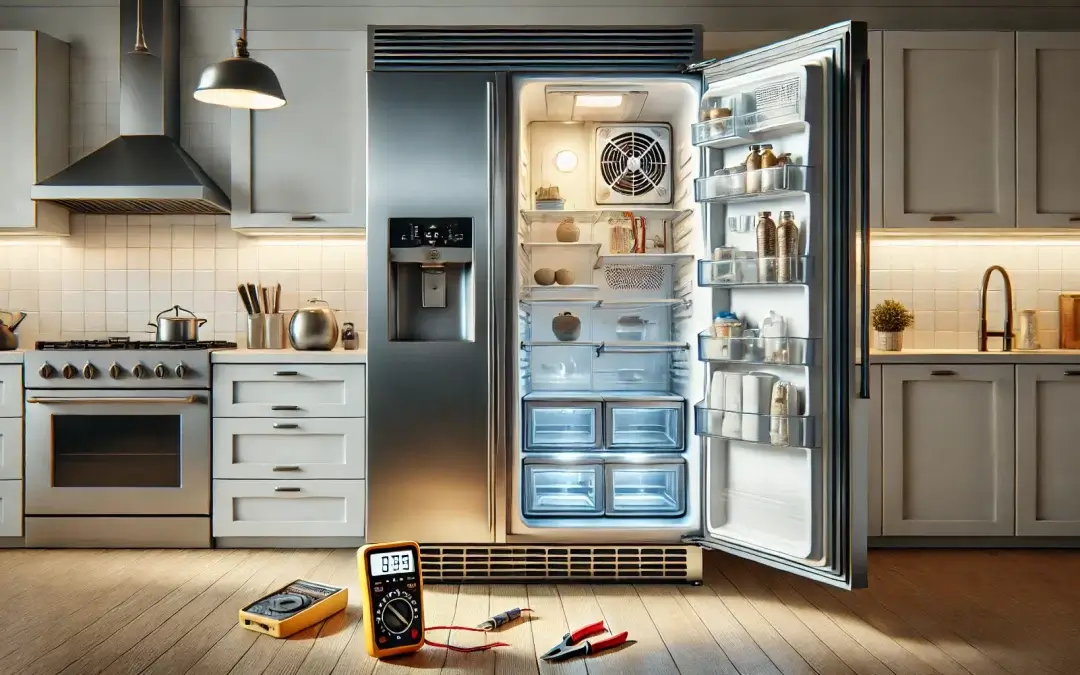Table of Contents
- 1. Check the Power Supply and Settings
- 2. Inspect the Condenser Coils for Dirt and Dust
- 3. Examine the Evaporator Fan
- 4. Check the Thermostat Settings
- 5. Assess the Door Gaskets for Leaks
- 6. Look for Frost Buildup in the Freezer
- 7. Investigate the Compressor for Issues
- 8. Test the Start Relay
- 9. Ensure the Vents Are Clear
- 10. Check the Defrost System
- 11. Examine the Temperature Control Board
- 12. Test the Door Switch
- 13. When to Call a Professional
- Conclusion
1. Check the Power Supply and Settings
Before diving into complex repairs, the first step is to check if your refrigerator is getting power. Sometimes, the issue might be as simple as a power outage, a tripped circuit breaker, or an unplugged power cord.
Solution: Ensure the refrigerator is plugged in and the power cord is securely connected to the outlet. Check the circuit breaker or fuse box for any tripped breakers or blown fuses. If the refrigerator is receiving power, confirm that the internal temperature settings are correct. The ideal temperature for a refrigerator is between 37°F (3°C) and 40°F (4°C).
2. Inspect the Condenser Coils for Dirt and Dust
Condenser coils are responsible for dissipating heat from the refrigerator. Over time, these coils can accumulate dust and debris, reducing their efficiency and causing the refrigerator to stop cooling properly.
Solution: Locate the condenser coils, usually found at the back or bottom of the refrigerator. Unplug the refrigerator and use a coil brush or a vacuum cleaner with a brush attachment to gently clean the coils. Remove any dust, dirt, or pet hair. Cleaning the coils can improve airflow and cooling efficiency.
3. Examine the Evaporator Fan
The evaporator fan circulates cool air throughout the refrigerator and freezer compartments. If the fan is not working correctly, it can lead to uneven cooling or a complete lack of cooling.
Solution: Open the freezer compartment and listen for the sound of the evaporator fan running. If you don’t hear it, the fan may be faulty or blocked. Unplug the refrigerator and remove the freezer’s back panel to access the fan. Check for any obstructions or signs of damage. If the fan blades are broken or the motor is defective, replace the fan.
4. Check the Thermostat Settings
A faulty thermostat can prevent the refrigerator from reaching the desired temperature, causing it to stop cooling effectively.
Solution: Locate the thermostat inside the refrigerator. It’s usually a dial or digital control. Turn the thermostat to the lowest setting and listen for a clicking sound, indicating it’s working.
If there’s no sound, the thermostat might be defective and need replacement. Consult your refrigerator’s manual for the specific model’s instructions on replacing the thermostat.
5. Assess the Door Gaskets for Leaks
The door gaskets create an airtight seal around the refrigerator door, keeping cold air in and warm air out. Over time, gaskets can become worn, cracked, or loose, leading to air leaks and poor cooling.
Solution: Inspect the gaskets around the refrigerator and freezer doors for cracks, tears, or signs of wear. To test the gasket’s seal, close the door on a piece of paper and try to pull it out. If the paper slides out easily, the gasket isn’t sealing properly.
Clean the gaskets with warm, soapy water and a cloth to remove any dirt or grime that might affect the seal. If damaged, replace the gaskets to restore the airtight seal.
6. Look for Frost Buildup in the Freezer
Excessive frost buildup in the freezer can block air vents, restrict airflow, and reduce cooling efficiency in both the freezer and refrigerator compartments.
Solution: Check the freezer for excessive frost or ice buildup. If frost is present, unplug the refrigerator and allow it to defrost. Once defrosted, clean the freezer with a cloth. To prevent frost buildup in the future, ensure that the freezer door is closing properly and not left open for extended periods.
7. Investigate the Compressor for Issues
The compressor is the heart of the refrigerator’s cooling system. If the compressor is not running or making strange noises, it could indicate a problem that needs attention.
Solution: Listen for the sound of the compressor running. If it’s silent or making unusual noises, it might be faulty. Check the relay and capacitor attached to the compressor for any signs of damage. If the compressor is not functioning correctly, it may need to be replaced by a professional technician.
8. Test the Start Relay
The start relay helps the compressor start and run efficiently. A faulty start relay can prevent the compressor from running, leading to cooling problems.
Solution: Unplug the refrigerator and locate the start relay, usually found on the side of the compressor. Remove the relay and shake it gently. If you hear a rattling sound, it’s likely defective and needs replacement. Install a new start relay to see if it resolves the cooling issue.
9. Ensure the Vents Are Clear
Refrigerators have vents that allow cold air to circulate between the freezer and refrigerator compartments. Blocked vents can disrupt airflow, causing uneven cooling or no cooling at all.
Solution: Check the vents inside the refrigerator and freezer compartments for any obstructions, such as food containers or ice buildup. Ensure that nothing is blocking these vents and that air can flow freely. Rearrange items in the refrigerator to allow better airflow.
10. Check the Defrost System
A malfunctioning defrost system can cause ice to build up on the evaporator coils, restricting airflow and reducing cooling efficiency.
Solution: The defrost system consists of the defrost timer, heater, and thermostat. If any of these components fail, ice buildup can occur. Unplug the refrigerator and manually advance the defrost timer to see if it starts the defrost cycle.
If not, the defrost timer may need replacement. Similarly, check the defrost heater and thermostat for continuity with a multimeter. Replace any defective parts to restore proper defrost function.
11. Examine the Temperature Control Board
The temperature control board regulates the cooling system’s operation. A malfunctioning board can prevent the refrigerator from cooling effectively.
Solution: If other components seem to be working correctly, but the refrigerator still isn’t cooling, the temperature control board could be at fault. Inspect the board for any visible signs of damage, such as burnt areas or broken connectors. If you suspect the board is defective, consult a professional technician to diagnose and replace it.
12. Test the Door Switch
The door switch turns on the light inside the refrigerator when the door is opened and signals the cooling system to pause. A faulty switch can cause the cooling system to malfunction.
Solution: Open the refrigerator door and press the door switch. If the light doesn’t turn off, the switch may be faulty. Test the switch for continuity with a multimeter. If defective, replace the door switch to restore proper operation.
13. When to Call a Professional
While many refrigerator cooling issues can be fixed with DIY solutions, some problems require professional help. If you’ve tried the above steps and your refrigerator still won’t cool, or if you’re unsure about performing certain repairs, it’s best to call a professional appliance repair technician.
Conclusion
Fixing a refrigerator that won’t cool involves identifying the root cause and applying the appropriate solution. Whether it’s cleaning dirty condenser coils, replacing a faulty thermostat, or unblocking vents, most issues can be resolved with a little time and effort.
Regular maintenance and timely repairs can extend the life of your refrigerator and keep it running efficiently. If you encounter persistent problems, don’t hesitate to seek professional assistance.


